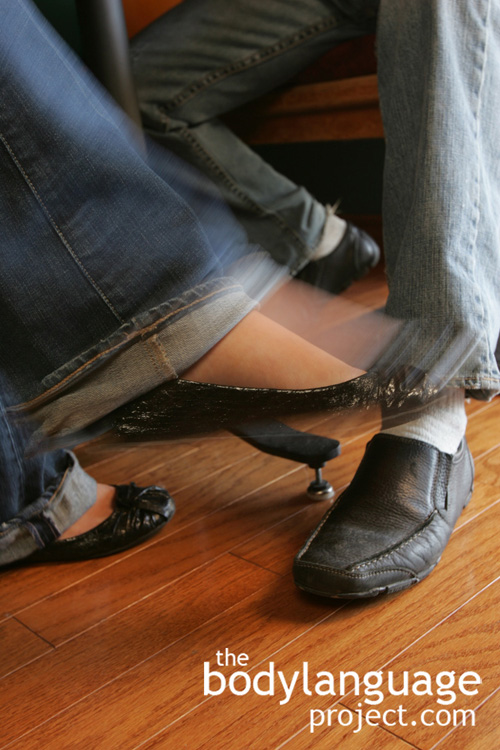Body Language of Hand To Nose
 Cue: Hand To Nose
Cue: Hand To Nose
Synonym(s): Nose Touching
Description: Touching the nose, usually with the index finger or pinching it with the webbing of the thumb and index finger.
In One Sentence: Touching the nose indicates discomfort, or serves to alleviate an itch.
How To Use it: When possible make touches to the nose and other parts of the face brief and directed, as persistent nose touching is often misread as dishonesty. At worst, touching the nose is read as insecurity.
Context: General.
Verbal Translation: “I’m stressed, and the blood if flowing to my nose, making me want to scratch it.”
Variant: Nose touching can happen as a quick but purposeful touch, the finger might graze the side of the nose, or it can be a persistent rubbing. Sometimes the touch is quick and dirty in an up and down motion, other times it is a brief almost unnoticeable touch to the base of the nose or its side. A person might wipe the nose with the back of their hand or come up and touch it lightly with their index finger. See Hand To Eye Gesture.
Cue In Action: During the Grand Jury testimony over Monica Lewinsky, Bill Clinton touched his nose 26 times when answering highly emotional questions. When he answered questions he found easy, his hands were nowhere near his face.
Meaning and/or Motivation: Touching the nose with the hand is a discomfort gesture linked to anxiety and therefore serves as a pacifier. Other times touching the nose provides clues that a person is lying as it indicates stress.
Face touching can come in two forms, one that serves a real function, to alleviate an itch, and one that is the result of negative feelings such as being uncomfortable and stressed. Face touching that is due to an emotion is meant as a fix behind the sensation, the emotion, and not due to any physical need.
Touching the nose has been linked to lying, but like most lie-detection cues, they aren’t absolute or reliable. We can tell when something is out of the ordinary when someone touches their nose for no reason or touches their nose while delivering critical information. The astute will find it obvious when someone is touching their nose for the purpose of alleviating an itch instead of alleviating a lie (or negative thought). Scratching is directed, specific, deep and vigorous, showing that some amount of waiting was done before the gesture was performed. Thus more relief is present when the itch is real. Itching due to negative emotions is general, shallow or glancing. This type of itch is done by bringing the index finger up, by example, and lightly touching the side of the nose where the nail is not used at all. That is, no real scratching is taking place.
When nose touching is not due to itching, then it’s due to a negative or dishonest thought from either lying, being terrified, pretending to be brave or just feeling self doubt.
Chemical known as catecholamine triggers nasal tissue to swell, but that it only induces the nose to increase in size below the level of perception. This is the real life Pinocchio effect. Even though most people will not be able to detect it, the increase in blood flow and pressure often causes a tingle in the nose, which in most people, triggers an itch response.
Some people touch their nose at the end of every sentence – it’s their idiosyncrasy. Does this mean that every word that comes from their mouth is a lie? It could be, but it is not likely. Once we’ve caught someone in a lie we can backtrack and look at the clues that preceded the lie and those that followed the lie to pick up on cues that might have given him away.
Cue Cluster: Touching the nose coupled with wiping the mouth in a down-stroke, avoiding eye contact, and fidgeting, tells us that something dishonest is probably going on.
Body Language Category: Adaptors, Amplifier, Arousal, Auto contact or self touching, Disguised gestures, Lying or deceptive body language, Masked body language, Microgestures, Pacifying, Stressful body language.
Resources:
Akehurst, L., G. Kohnken, A. Vrij, and R. Bull. 1996. Lay persons’ and police officers’
beliefs regarding deceptive behaviour. Applied Cognitive Psychology 10: 461-471.
Appelbaum, P.S. The new lie detectors: Neuroscience, deception, and the courts. Psychiatric Services. 2007. 58: 460-462.
Azrin, N.H. ; Nunn, R.G. ; Frantz-Renshaw, S. Habit reversal treatment of thumbsucking. Behaviour Research and Therapy. 1980. 18(5): 395-399.
Bakwin, Harry. Thumb- and finger-sucking in children. The Journal of Pediatrics. 1948. 32(1): 99-101.
Barroso, Felix ; Feld, Jason. Self-touching and attentional processes: The role of task difficulty, selection stage, and sex differences. Journal of Nonverbal Behavior. 1986. 10(1): 51-64.
Buckley, V., & Semple, S. (2012). Evidence that displacement activities facilitate behavioural transitions in ring-tailed lemurs. Behavioural Processes, 90, 433–435.
Bouhuys, A.L. ; Jansen, C.J. ; van den Hoofdakker, R.H. Analysis of observed behaviors displayed by depressed patients during a clinical interview: relationships between behavioral factors and clinical concepts of activation. Journal of Affective Disorders. 1991. 21(2): 79-88.
Berridge CW,Mitton E, ClarkW, Roth RH. 1999. Engagement in a non-escape (displacement) behavior elicits a selective and lateralized suppression of frontal cortical dopaminergic utilization in stress. Synapse 32:187–197.
Bond, Michael H., and Hiroshi Komai (1976). “Targets of Gazing and Eye Contact During Interviews: Effects on Japanese Nonverbal Behavior.” In Journal of Personality and Social Psychology (Vol. 34), pp. 1276-84.
Blakeslee, Sandra (1995). “In Brain’s Early Growth, Timetable Maybe Crucial.” In New York Times (“Science Times,” August 29), pp. C1, C3.
Cohen, Keith N. ; Clark, James A. Hogan, Robert (editor). Transitional object attachments in early childhood and personality characteristics in later life. Journal of Personality and Social Psychology. 1984. 46(1): 106-111.
Caso, L., A. Gnisci, A. Vrij, and S. Mann. 2005. Processes underlying deception: an empirical analysis of truth and lies when manipulating the stakes. Journal of Investigative Psychology and Offender Profiling 2 (3): 195-202.
Costa, Marco ; Dinsbach, Wies ; Manstead, Antony ; Bitti, Pio. Social Presence, Embarrassment, and Nonverbal Behavior. Journal of Nonverbal Behavior. 2001. 25(4): 225-240.
DeSteno, D.; Breazeal, C.; Frank, R. H.; Pizarro, D.; Baumann, J.; Dickens, L, and Lee, J. Detecting the Trustworthiness of Novel Partners in Economic Exchange. Psychological Science. 2012. 23, 1549-1556.
http://bodylanguageproject.com/articles/use-body-language-cues-create-trust
D’alessio, M. ; Zazzetta, A. Development of Self-Touching Behavior in Childhood. Perceptual and Motor Skills. 1986. 63(1): 243-253.
Elaad, E. 2003. Effects of feedback on the overestimated capacity to detect lies and the underestimated ability to tell lies. Applied Cognitive Psychology 17(3): 349-363.
Edelstein, R. S., T. L. Luten, P. Ekman, and G. S. Goodman. 2006. Detecting lies in children and adults. Law and Human Behavior 30(1): 1-10.
Ekman, Paul, and Wallace V. Friesen (1969). “Nonverbal Leakage and Clues to Deception.” In Psychiatry (Vol. 32), pp. 88-106.
Frank M.G. and Ekman P. 1997. The ability to detect deceit generalizes across different types of high-stake lies. Source: Journal of personality and social psychology. 72: 1429 -39
Foster, Laura Gutermuth. Nervous Habits and Stereotyped Behaviors in Preschool Children. Journal of the American Academy of Child & Adolescent Psychiatry. 1998. 37(7): 711-717.
Friman, P C ; Mcpherson, K M ; Warzak, W J ; Evans, J. Influence of thumb sucking on peer social acceptance in first-grade children. Pediatrics. 1993. 91(4): 784-6.
Gordon, A. K. and A. G. Miller. 2000. Perspective differences in the construal of lies: is deception in the eye of the beholder? Personality and Social Psychology Bulletin 26 (1): 46-55.
Garnefski N 2004) Cognitive emotion regulation strategies and depressive symptoms: differences between males and female. Personal Indiv Diff 36: 267–76.
Goldberg, Shelly ; Rosenthal, Robert. Self-touching behavior in the job interview: Antecedents and consequences. Journal of Nonverbal Behavior. 1986. 10(1): 65-80.
Goodall, Jane (1986). The Chimpanzees of Gombe: Patterns of Behavior (Cambridge: Belknap Press of Harvard University).
Givens, David B. (1976). An Ethological Approach to the Study of Human Nonverbal Communication (University of Washington Ph.D. dissertation in Anthropology, Ann Arbor: University Microfilms).
Grand, Stanley (1977). “On Hand Movements During Speech: Studies of the Role of Self-Stimulation in Communication Under Conditions of Psychopathology, Sensory Deficit, and Bilingualism.” In Norbert Freedman and Stanley Grand, eds., Communicative Structures and Psychic Structures: A Psycholanalytic Interpretation of Communication (New York: Plenum Press), pp. 199-221.
Harrigan, Jinni A. Self-touching as an indicator of underlying affect and language processes. Social Science & Medicine. 1985. 20(11): 1161-1168.
Harrigan, Jinni A.; Karen S. Lucic; Denise Kay; Anne McLaney and Robert Rosenthal. Effect of Expresser Role and Type of Self-Touching on Observers’ Perceptions. Journal of Applied Social Psychology. 1991. 21(7): 585-609.
Hall, Jeffrey A. and Chong Xing. The Verbal and Nonverbal Correlates of the Five Flirting Styles. Journal of Nonverbal Behavior. 2015. 39:41–68. DOI 10.1007/s10919-014-0199-8
http://bodylanguageproject.com/articles/first-12-minutes-flirting-using-nonverbal-communication-study-reveals-26-body-language-cues-attraction/
Huflejt-Łukasik M, Czarnota-Bojarska J (2006) Short Communication: Selffocused attention and self-monitoring influence on health and coping with stress. Stress Health 22: 153–59.
Heaven, Laura ; Mcbrayer, Dan ; Prince, Bob. Role of sex in externally motivated self-touching gestures. Perceptual and motor skills. 2002. 95(1): 289-94.
Heaven, L ; Mcbrayer, D. External motivators of self-touching behavior. Perceptual and motor skills. 2000. 90(1): 338-42.
Huflejt-Łukasik M, Czarnota-Bojarska J (2006) Short Communication: Selffocused attention and self-monitoring influence on health and coping with stress. Stress Health 22: 153–59.
Honzik, Marjorie P. ; McKee, John P. The sex difference in thumb-sucking. The Journal of Pediatrics. 1962. 61(5): 726-732.
Juni, Samuel ; Cohen, Phyllis. Partial impulse erogeneity as a function of fixation and object relations. Journal of Sex Research. 1985. 21(3): 275-291.
Katza, Carmit; Irit Hershkowitz; Lindsay C. Malloya; Michael E. Lamba; Armita Atabakia and Sabine Spindlera. Non-Verbal Behavior of Children Who Disclose or do not Disclose Child Abuse in Investigative Interviews. Child Abuse & Neglect. 2012. 36: 12-20.
http://bodylanguageproject.com/articles/reading-nonverbal-behaviour-child-abuse-cases-encourage-children-divulge-information-truth-telling
Kenner, Andrew N. (1993). “A Cross-Cultural Study of Body-Focused Hand Movement.” In Journal of Nonverbal Behavior (Vol. 17, No. 4, Winter), pp. 263-79.
Lehman, E.B., Holtz, B.A., & Aikey, K.L. (1995). Temperament and self-soothing behaviour in children: Object attachment, thumbsucking, and pacifier use. Early Education and Development, 6(1), 53–72.
Mohiyeddini, Changiz ; Semple, Stuart. Displacement behaviour regulates the experience of stress in men. Stress. 2013. 16(2): 163-171.
Mohiyeddini, C., Bauer, S., & Semple, S. (2013a). Displacement behaviour is associated with reduced stress levels among men but not women. PLoS One, 8, e56355.
Mohiyeddini, C., Bauer, S., & Semple, S. (2013b). Public self-consciousness moderates the link between displacement behaviour and experience of stress in women. Stress, 16, 384–392.
Mann, S., A. Vrij, and R. Bull. 2002. Suspects, lies, and videotape: an analysis of authentic high-stake liars. Law and Human Behavior 26 (3): 365-376.
Mann, S., A. Vrij, and R. Bull. 2004. Detecting true lies: police officers’ ability to detect suspects’ lies. Journal of Applied Psychology 89(1): 137-149.
Moore, M. M. and D. L. Butler. 1989. Predictive aspects of nonverbal courtship behavior in women. Semiotica 76(3/4): 205-215.
Moore, M. M. 2001. Flirting. In C. G. Waugh (Ed.) Let’s talk: A cognitive skills approach to interpersonal communication. Newark, Kendall-Hunt.
Moore, M. M. 1985. Nonverbal courtship patterns in women: context and consequences. Ethology and Sociobiology 64: 237-247.
Moore, M. M. 2001. Flirting. In C. G. Waugh (Ed.) Let’s talk: A cognitive skills approach to interpersonal communication. Newark, Kendall-Hunt.
Mahalski, P. (1983). The incidence of attachment objects and oral habits at bedtime in two longitudinal samples of children aged 1.5–7 years. Journal of Child Psychology and
Psychiatry, 24(2), 283–295.
Maestripieri D, Schino G, Aureli F, Troisi A. 1992. A modest proposal: displacement activities as an indicator of emotions in primates. Anim Behav 44:967–979.
Morris, Desmond (1994). Bodytalk: The Meaning of Human Gestures (New York: Crown Publishers).
McGrew, W. C. (1972). “Aspects of Social Development in Nursery School Children with Emphasis on Introduction to the Group.” In N. G. Blurton Jones, ed., Ethological Studies of Child Behaviour (Cambridge: University Press), pp. 129-56.
Nolen-Hoeksema S, Aldao A (2011) Gender and age differences in emotion regulation strategies and their relationship to depressive symptoms. Personal Indiv Diff 51: 704–8.
Park, H. S., T. R. Levine, S. A. McCornack, K. Morrison, and M. Ferrara. How people really detect lies. Communication Monographs. 2002. 69: 144-157.
Pecora, Giulia ; Addessi, Elsa ; Schino, Gabriele ; Bellagamba, Francesca. Do displacement activities help preschool children to inhibit a forbidden action? Journal of Experimental Child Psychology. 2014. 126: 80-90.
Pease, Barbara and Allan Pease. 2006. The Definitive Book of Body Language Hardcover. Bantam.
Pugh, George E. (1977). The Biological Origin of Human Values (New York: Basic Books).
Rosenfeld, Howard (1973). “Nonverbal Reciprocation of Approval: An Experimental Analysis.” In Argyle *, pp. 163-72.
Sommer, Robert (1969). Personal Space: The Behavioral Basis of Design (Englewood Cliffs, New Jersey: Prentice-Hall).
Stromwell, L. A., P. A. Granhag, and S. Landstrom. 2007. Children’s prepared and unprepared lies: can adults see through their strategies? Applied Cognitive Psychology 21 (4): 457-471.
Sturman, Edward D. Invluntary Subordination and Its Relation to Personality, Mood,
and Submissive Behavior. Psychological Assessment. 2011. 23(1): 262-276 DOI: 10.1037/a0021499
http://bodylanguageproject.com/articles/nonverbal-submission-men-women-depression-critical-examination-use-disuse-submission/
Schino G, Perretta G, Taglioni AM, Monaco V, Troisi A. 1996. Primate displacement activities as an ethopharmacological model of anxiety. Anxiety 2:186–191.
Teixeira Fiquer, Juliana; Paulo Sérgio Boggio and Clarice Gorenstein. Talking Bodies: Nonverbal Behavior in the Assessment of Depression Severity. Journal of Affective Disorders. 2013. 150: 1114-1119.
http://bodylanguageproject.com/articles/using-nonverbal-behaviour-to-assess-depression-severity/
Tamres L, Janicki D, Helgeson VS (2002) Sex differences in coping behaviour: a meta-analytic review. Personal Soc Psychol Rev 6: 2–30.
Troisi A (2002) Displacement activities as a behavioural measure of stress in nonhuman primates and human subjects. Stress 5: 47–54.
Troisi A (1999) Ethological research in clinical psychiatry: the study of nonverbal behaviour during interviews. Neurosci Biobehav Rev 23: 905–913.
Troisi A, Moles A (1999) Gender differences in depression: an ethological study of nonverbal behaviour during interviews. J Psychiatr Res 33: 243–250.
Tamres L, Janicki D, Helgeson VS (2002) Sex differences in coping behaviour: a meta-analytic review. Personal Soc Psychol Rev 6: 2–30.
von Hippel W, von Hippel C, Conway L, Preacher KJ, Schooler JW, et al. (2005) Coping with stereotype threat: denial as an impression management strategy. J Personal Soc Psychol 89: 22–35.
Vrij, A. and G. R. Semin. 1996. Lie experts’ beliefs about nonverbal indicators of deception. Journal of Nonverbal Behavior 20: 65-80.
Vrij, A. 1997. Individual differences in hand movements during deception. Source: Journal of nonverbal behavior. 21: 87-102.
Vrij, A.. 2004. Why professionals fail to catch liars and how they can improve Source: Legal and Criminological Psychology. 9:159-181.
Vrij, A., S. Mann, and S. Kristen. 2007. Cues to deception and ability to detect lies as a function of police interview styles. Law and Human Behavior 31 (5): 499-518.




